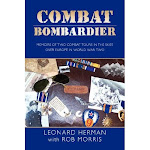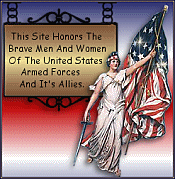 The Vergene W. Ford Crew, 335th Squadron, 95th Bomb Group. Back Row: Vergene Ford, Pilot; Murray Saylor, Copilot; Julian Meyer, Bombardier; Cletus Comisky, Navigator. Front Row: Ken Hutcherson, Radio Operator; Willis Perry, Top Turret Gunner/Engineer; Robert Evans, Waist Gunner; Richard Peterson, Ball Turret Gunner; Marvin Casaday, Armorer/Waist Gunner; Leonard Styczynski (Stevens); Tail Gunner. (Photo from 95th BG website)
The Vergene W. Ford Crew, 335th Squadron, 95th Bomb Group. Back Row: Vergene Ford, Pilot; Murray Saylor, Copilot; Julian Meyer, Bombardier; Cletus Comisky, Navigator. Front Row: Ken Hutcherson, Radio Operator; Willis Perry, Top Turret Gunner/Engineer; Robert Evans, Waist Gunner; Richard Peterson, Ball Turret Gunner; Marvin Casaday, Armorer/Waist Gunner; Leonard Styczynski (Stevens); Tail Gunner. (Photo from 95th BG website) Another crew photo. Ken Hutcherson is in the back row, second from left. (Photo from 95th BG Website)
Another crew photo. Ken Hutcherson is in the back row, second from left. (Photo from 95th BG Website) 95th Bomb Group Veteran Kenneth Hutcherson poses at the crossroads near Horham during his return visit in August, 1972. Hutcherson flew with the 335th Squadron as a Radio Operator on a B-17 Flying Fortress during World War Two. (Photo courtesy of Kenneth Hutcherson)
95th Bomb Group Veteran Kenneth Hutcherson poses at the crossroads near Horham during his return visit in August, 1972. Hutcherson flew with the 335th Squadron as a Radio Operator on a B-17 Flying Fortress during World War Two. (Photo courtesy of Kenneth Hutcherson)This is one of my favorite written accounts of a World War Two bomber crewman's return to his old base. The full version will be appearing in the 95th BG history, out next year. Kenneth Hutcherson was a young radio operator on a B-17 crew when he first saw Horham during the war. He wrote of his return in August of 1972:
"It was a beautiful summer day the likes of which we rarely saw during the summer of 1944," he begins, "The train for Ipswich, Diss and Norwich, left at 8:30 AM so we got up at 7, had a quick breakfast at the Hilton (not like the ones we used to get at the Regent Palace) and took the tube to the Liverpool Street Station...
"We finally managed to get a seat in a compartment not unlike the ones all of us remember vaguely with the webbing overhead for packages and luggage...
After arriving at the train station at Diss, Hutcherson hailed a cab to Horham. The driver was not certain how to find the old base in nearby Horham, and had to stop several times to ask for directions. But finally, "after travelling the eight miles to Horham, we pulled onto a hard stand at the edge of a wheat field and said we were there. It was hard for me to get my bearings at first. There was a farmer across the road on a combine mowing his wheat. He stopped his tractor and came over to assist us and everything started to fall into place.
"One of the headquarters buildings was still there and the farmer took us through the briars and underbrush to get inside. You would find it hard to believe but there were still pin-up pictures pasted on the wall from Yank Magazine and also a Sad Sack cartoon stenciled on one wall. Over one doorway was stenciled 'Through These Doors Pass the Best Damn Flyers in the World'. What an experience!
"Our barracks from the 335th Squadron was a crumbled mess of corrugated rusty steel. We couldn't get back there because of the crops and no roads but I took a picture of it from the distance. The control tower crumbled last year but the main runway was still there. We drove down the runway which is still used for small planes for crop dusting. We took pictures there and also at the crossroads with the signs--Horham, Diss, Ipswich, Norwich and Eye. On the way back to Diss we stopped and took pictures of the thatched roof houses which I did not remember."
Upon arrival at Diss, the Cockney taxi driver refused to accept a tip, though he had stayed with them all day long. "I'm a cockney from London...and my word is my bond," he told Hutcherson."
Hutcherson finally persuaded the cabbie to take two pounds. Interestingly, Hutcherson had never visited the town of Diss during the war, as it was off-limits.
He then boarded the train, the mists of time again wrapped his memories in a comfortable embrace, and he returned to London.






No comments:
Post a Comment